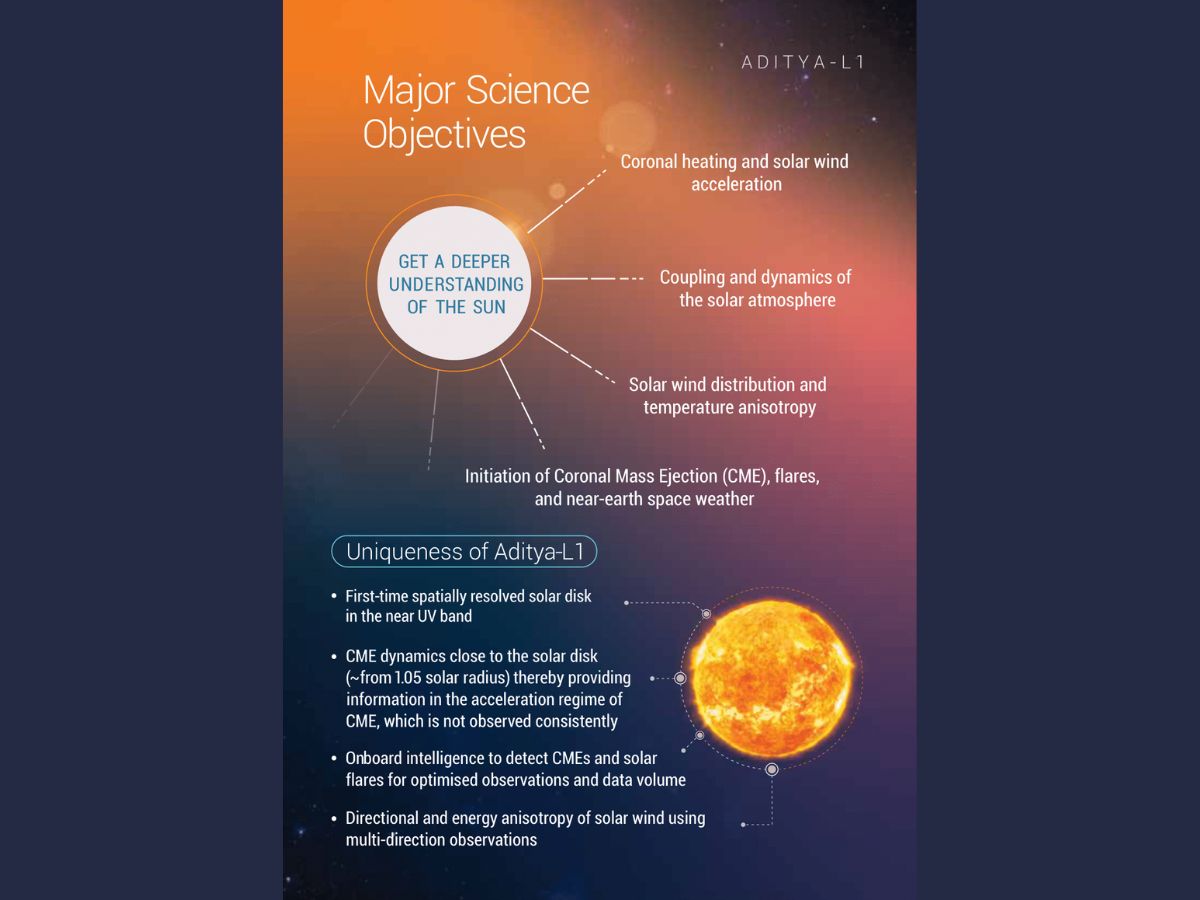Aditya-L1: What Makes India's First Space-Based Solar Observatory To Study The Sun Unique
Aditya-L1, India’s first space-based solar observatory to study the Sun, is unique because of several reasons. It will be placed at a special location, and has a distinctive set of science objectives.

Aditya-L1, India’s first space-based solar observatory to study the Sun, is unique because of several reasons. Set to be launched on September 2, 2023, Aditya-L1 will be placed at a special location, and has a distinctive set of science objectives. The Indian Space Research Organisation (ISRO) aims to place Aditya-L1 at a halo orbit around Lagrange point 1 (L1).
Aditya-L1 is set to be launched on September 2, at 11:50 am IST, from Satish Dhawan Space Centre, Sriharikota, Andhra Pradesh, atop a PSLV-XL (Polar Satellite Launch Vehicle) rocket. The solar observatory is expected to have a mission duration of five years.
Here are eight points which make Aditya-L1 a unique mission.
- Aditya-L1 will be placed around L1, which is a special point in space that will not only allow the solar observatory to save fuel and conserve energy by remaining in a fixed position, but will also provide the spacecraft an uninterrupted view of the Sun for the entirety of its mission.
Aditya-L1 will not witness any solar eclipses or occultations, and hence, the observatory can continuously observe solar activities and their impact on space weather in real time.
An occultation is an astronomical phenomenon in which the light from a celestial body is completely obstructed by another cosmic object such as a star or a planet. A solar eclipse occurs when the Moon comes in between the Sun and the Earth, and a lunar eclipse happens when the Earth comes in between the Sun and the Moon, casting a shadow on Earth’s only natural satellite.
A solar eclipse can be described as an occultation of the Sun by the Moon, and a lunar eclipse can be classified as an occultation of the Moon by the Earth. Therefore, all total eclipses are occultations, but all occultations are not eclipses.
- Aditya-L1's trajectory towards L1 is unique. After being launched from Sriharikota, Aditya-L1 will be placed in a low-Earth orbit. After this, Aditya-L1 will undergo orbit-raising manoeuvres to ensure that after each perigee burn, the orbit becomes more and more elliptical.
After three orbit-raising manoeuvres, Aditya-L1 will exit Earth's sphere of influence. Next, the observatory will enter the cruise phase. This refers to the stage between departure from Earth's sphere of influence, and insertion into the orbit around the final destination.
MUST READ: EXCLUSIVE | Chandrayaan-3 Is A 'Huge Confidence Booster', Can Help Reverse Brain Drain, CERN Scientist Archana Sharma Says
The stage after the cruise phase is halo orbit insertion in L1. Aditya-L1 is expected to reach a large halo orbit around L1 about four months from launch.
The observatory will remain in orbit for five years, studying the Sun.

- Aditya-L1 is the first spacecraft which will spatially resolve the solar disk in the near-ultraviolet band. The solar disk is the circular visible surface of the Sun.
Spatial resolution refers to a measure of the smallest object that can be resolved by a sensor, and allows two neighbouring structures to be distinguished as separate.
ALSO READ | Chandrayaan, Apollo, Artemis, Luna – Successful Moon Missions Launched Till Date
Therefore, Aditya-L1 will spatially resolve the solar disk in the near ultraviolet band.
- Aditya-L1 will also study the dynamics of coronal mass ejections close to the solar disk. Large expulsions of plasma and magnetic fields from the Sun's corona are called coronal mass ejections.
Aditya-L1 will study these dynamics at a distance of 1.05 solar radius. Solar radius, which refers to the radius of the Sun till a certain layer in the photosphere, is used as a unit of distance to express the size of stars, relative to that of the Sun. This means that Aditya-L1 will make measurements of the coronal mass ejections at a distance 1.05 times the solar radius, from the solar disk.
- Aditya-L1 is equipped with onboard intelligence that renders the spacecraft capable of detecting coronal mass ejections and solar flares. The observatory's instruments will make optimised observations and obtain enhanced data.
Solar winds have different energies in different directions. This is referred to as energy anisotropy. Aditya-L1 will study the directional and energy anisotropies of solar winds using multi-direction observations.
ALSO READ | After Chandrayaan-3 Softly Lands On Moon, ISRO Sets Eyes On The Aditya-L1 Solar Mission. All About It
-
Aditya-L1 intends to delve into the entire surface of the Sun, said Manish Purohit, a former ISRO scientist who was involved in the Chandrayaan-2 and Mangalyaan missions. The spacecraft will study a vast area where temperatures can vary immensely, reaching millions of Kelvins in some spots of the solar corona, and a few thousand Kelvins in others, he explained.
-
Aditya-L1 aims to solve an ongoing puzzle, by leveraging its strategic location around L1. The observatory intends to understand why significant temperature differences are witnessed across the surface of the Sun, Purohit explained. "By comprehensively observing the Sun's behaviour from its vantage at L1, Aditya-L1 aims to unlock the secrets behind the remarkable temperature variations on the Sun's sprawling disk."
-
Aditya-L1 will obtain a deeper understanding of the Sun by accomplishing its major science objectives of studying coronal heating and solar wind acceleration, coupling and dynamics of the solar atmosphere, solar wind distribution and temperature anisotropy, and the initiation of coronal mass ejections, solar flares, and the dynamics of near-Earth space weather.
Solar coupling refers to the firm connection between the solar magnetic field and the Sun by the highly conducting solar atmosphere.
Related Video
Southern Rising Summit 2024: How Important is Self-Awareness? Insights from Anu Aacharya | ABP LIVE






































